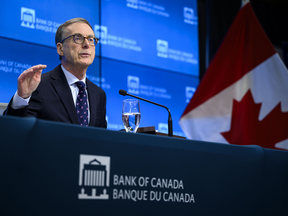The week in the economy in six charts
Article content
Financial Post columnist Kevin Carmichael, editor of the FP Economy newsletter, unpacks the week in economics.
Freeland’s ‘guardrails’
June 4 was Jobs Day in Canada and the United States, when the wonkiest of wonks celebrate the release of the latest monthly hiring data by taking to Twitter to demonstrate their chart-making skills.
Here at FP Economy, we prefer to save Gigi Suhanic’s artwork for our subscribers rather than the mobs that gather on Twitter. There are a few charts that we think best describe the current state of the labour market. Let’s have a look.
We track what the country’s most important policy-makers track. Finance Minister Chrystia Freeland said last year that her extraordinary emergency spending would be guided by “fiscal guardrails,” including total hours worked. That measure had almost returned to pre-pandemic levels, but then the third wave of COVID-19 restrictions forced authorities to tighten social-distancing measures. That setback caused hours worked to drop by four per cent in May from February 2020.
Advertisement
This advertisement has not loaded yet, but your article continues below.
Article content

Total hours is an aggregate number. It says a lot about how fast the economic machine is running, but it necessarily obscures a lot of detail. Freeland and her officials at the Finance Department also want to know the details. She wants to make sure that no one is being left behind. That’s why one of her “guardrails” is also long-term unemployment, which has spiked to levels last seen in the first half of the 1990s. Evidence shows that the longer people spend on the sidelines of the economy, the harder it is to get back in. Economists call it “scarring.” Freeland has pledged to spend heavily so the economy heals before such scars become permanent.

Read: Bianca Bharti reports on the factors that could complicate the summer rebound on which everyone is counting.
Bloomberg News: Trudeau government’s generous financial aid has become a key lifeline for the economy.
More from Bloomberg: Higher earners biggest beneficiaries of Trudeau’s pandemic aid.
Macklem’s Dashboard
Tiff Macklem completed the first year of his seven-year term on June 3. A year earlier, he oversaw the release of an interest-rate decision on which he played no official part. Last week, he would have been huddled with his deputies, deciding whether their current interest-rate stance needed tweaking ahead of a scheduled update on June 9. Hopefully someone at the central bank thought to mark the occasion. If they didn’t, Macklem still probably went home satisfied on Friday, as a big week of economic data supported his decision to look past the recent spike in inflation and let the economy run hot.
Advertisement
This advertisement has not loaded yet, but your article continues below.
Article content
Like Freeland, Macklem says he is watching a “broader set of indicators” than the headline numbers that attract the most attention, such as the national unemployment rate. He’s been coy about what his dashboard looks like, however, so we’re forced to guess.
Since the Bank of Canada itself has flagged the gap between youth unemployment and the jobless rate of workers who are older than 25, we assume that’s an indicator that the governor cares about. It continues to flash red.

The central bank also has made note of how high-wage workers are doing better than those at the lower end of the pay scale. If Macklem intends to do his part to narrow that gap, he will have to leave interest rates low for longer yet, according to Statistics Canada’s latest Labour Force Survey.

From the archives: Bank of Canada governor indicates readiness to let economy run hot to include more people in recovery.
Too much house
You might have heard of fiscal dominance. That happens when the public debt and deficit get so big that the central bank feels compelled to keep borrowing costs low to help the government avoid bankruptcy, rather than let itself be guided by economic conditions. Some think Bank of Canada Tiff Macklem is already being bullied by Prime Minister Justin Trudeau’s deficits. Macklem dismisses those charges, saying policy-makers have learned real-world concerns such as long-term unemployment deserve more attention than theoretical threats that are scarier in textbooks than in real life.
Advertisement
This advertisement has not loaded yet, but your article continues below.
Article content
A bigger concern for Canada might be real-estate dominance. Statistics Canada’s latest tally of gross domestic product on June 1 shows that residential investment has rarely been a bigger part of the overall economy. That’s great for real-estate brokers, but bad for competitiveness, because it suggests that houses are becoming a magnet for precious investment dollars that could be put to more productive uses. As Evan Siddall, the former head of Canada Mortgage and Housing Corp., tweeted in April, “Housing is mining our economic future.”


‘It’s not going to change’: The long and short of Canada’s job vacancy problem

Weekly earnings are steadily improving for some — and surging rapidly for others

‘Excess exuberance’ in housing harks back to the market frenzy of the 1990s
An international comparison might be helpful. Australia, another small and open economy that relies heavily on commodity exports, often makes a good foil for Canada. The Aussies have also shown a love of housing over the past decade, as Australian cities often show up alongside Canada’s bigger urban centres atop lists of the most expensive real estate on the planet. Australia also published first-quarter GDP figures last week. The chart below shows what investment looks like Down Under compared with what’s happening up here in the North. Australian policy-makers might want to nudge their entrepreneurs and executives to get more excited about intellectual property, a proxy for innovation in the digital economy. But it’s hard to look at those bars and avoid the conclusion that Canada is buying way too much house.

Kevin Carmichael: Disappointing GDP growth offsets worries central bank, governments are overdoing it
Read: Canada’s economy grows 5.6% — but it would have been worse without the housing boom
_____________________________________________________________
For more great stories sign up for FP Economy Newsletter.
_____________________________________________________________
• Email: kcarmichael@postmedia.com | Twitter: CarmichaelKevin
Advertisement
This advertisement has not loaded yet, but your article continues below.
Postmortem: Canada is buying too much house
2021-06-07 12:31:19






